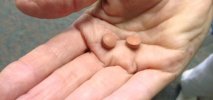New Treatment for Macular holes
Recent approval of Jetrea (Ocriplasmin) to treat symptomatic VMA (Vitreo Macular Adhesion) has opened up a new era in non surgical management of macular holes. Previously only a hospital based surgery was able to reverse the process of macular hole development but now a new drug can be injected into the eye painlessly in the office and within a few weeks the process reverses back to more normal vision levels.... more
FDA Approves ASRS Leader's ArgusŪ II Artificial Retina
On February 14, the FDA approved the Argus II artificial retina developed by ASRS Executive Committee and Board Member Mark S. Humayun, MD, PhD.
This breakthrough technology is the first ever to offer limited vision to patients with late-stage retinitis pigmentosa (RP).
Second Sight Medical Products (Sylmar, CA) manufactures the Argus II implant, which has 60 electrodes and a tiny camera mounted on eyeglasses to capture images.
The FDA approved Argus II for adults age 25 years or older with severe to profound RP. About 10,000 to 15,000 of the 100,000 Americans with RP will qualify for Argus II. Up to 4,000 patients a year can be treated with the device.
Macular degeneration and Aspirin?

Aspirin and Macular degeneration... is there an increase in the wet form of macular degeneration in those patients taking aspirin? The wet form develops quicker than the dry form. It may only be related to the fact that you are more likely to take aspirin if you have medical problems like stroke or heart attacks in the past and these conditions are more commonly associated with wet age related macular degeneration. ... more

Macular Pucker or Epiretinal Membrane
Overview:
A Macular Pucker occurs when a shrinking vitreous pulls on the retina and causes scar tissue to form. The resulting tissue can cause vision blurriness or distorted vision, although unlike macular degeneration or retinal detachment, symptoms usually progress rather slowly. Rapid changes in vision is probably not macula pucker and needs immediate exam.
Symptoms & Types:
With most macular puckers, vision is only slowly affected so that daily activities such as driving or reading can still be done for a while. Rarely, the scar tissue causing the macular pucker will separate from the retina itself without medical interference if there is a “vertical” component to the pulling. When the vision fails to the 20/40 or worse level, most patients will elect to have vitrectomy surgery to correct it. At times if the scar tissue is pulling on the central vision just right, a macular hole can form causing further deterioration of the reading vision.
Treatments:
Performed under anesthesia at the hospital, a surgeon will remove the liquid vitreous from the center of your eye to prevent it from pulling on your retina, and will also remove the scar tissue that is causing the pucker. There is not a good way of "ironing out" the wrinkles in the macula surgically therefore it takes a long time for the wrinkles in the macula to resolve after the offending scar tissue has been removed. This also means that allowing the macula to become severely distorted by waiting a long time before having surgery and allowing the wrinkles to be well established is not a good idea. This will be discussed at the time of examination.
Prevention:
As the risk of developing a macular pucker directly correlates with age, there is little to nothing that an individual can do to prevent a pucker from forming, other than to take routine precautions when eye problems are suspected and being sure to undergo an annual or bi-annual eye exam. Monitoring an amsler grid once a week is a good habit to have for thisw condition as it usually changes only slowly. Rapid changes to the amsler need to be seen quickly as there may be another condition causing the distortion. Other medical conditions such as high blood pressure and heart valve disease have also been weakly associated with this condition. Good medical exam by your primary medical doctor would identify these issues.






